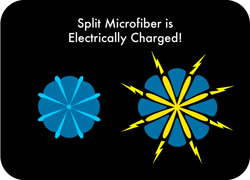During the last 30 years, microfibers have found broad use in various fields: industrial applications, textiles and even medicine. Many attributes define the composition of the fiber itself and also in the weaving of the different fabrics.
We can distinguish among them according to the intended use of the fibers: whether it is for garments, industrial textiles or cleaning applications.
The properties that are sought can be somehow opposite: while looking for a water repellent fabric to make a coat, one can look for a highly absorbent textile to make a mop. The many possibilities of microfibers allow both of these!
When designing the fibers, different factors come into play and will influence the structure of the fiber.
For instance, in apparel textile, if one needs a fiber with similar light reflecting qualities as silk for a shiny looking fabric, the microfiber's cross section will have to adapt, a square or ribbon shaped fiber's cross section allowing to reflect much more light than a classical round one.
 |
Fibers design offers even more possibilities in industrial or cleaning applications. Capillarity properties can be considerably enhanced following specific cross section designs, thus allowing specific filtration properties. Most cleaning microfibers have a so-called "pie wedges" cross section made of polyester and nylon (polyamide). Splitting those fibbers separates the nylon star-shaped core from the polyester wedges and divides the fiber into 9 different (in size, shape and composition) strands. As a result the fibers capacities, such as water absorption or dust attraction are greatly increased.
Weaving has also a direct impact on the properties that are sought. A tightly woven fabric will be very efficient to repel water and protect from the wind, making it useful for apparel. Some microfibers mops on the other hand try to expose the most fibers so as they can penetrate any corner and cover the whole surface to catch the dust.




